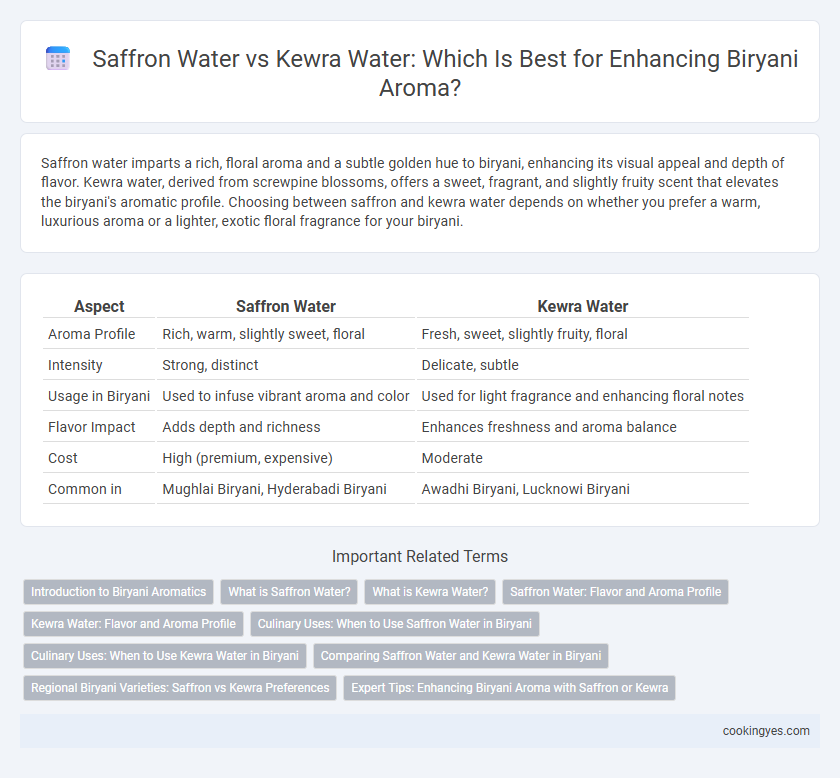Saffron water imparts a rich, floral aroma and a subtle golden hue to biryani, enhancing its visual appeal and depth of flavor. Kewra water, derived from screwpine blossoms, offers a sweet, fragrant, and slightly fruity scent that elevates the biryani's aromatic profile. Choosing between saffron and kewra water depends on whether you prefer a warm, luxurious aroma or a lighter, exotic floral fragrance for your biryani.
Table of Comparison
| Aspect | Saffron Water | Kewra Water |
|---|---|---|
| Aroma Profile | Rich, warm, slightly sweet, floral | Fresh, sweet, slightly fruity, floral |
| Intensity | Strong, distinct | Delicate, subtle |
| Usage in Biryani | Used to infuse vibrant aroma and color | Used for light fragrance and enhancing floral notes |
| Flavor Impact | Adds depth and richness | Enhances freshness and aroma balance |
| Cost | High (premium, expensive) | Moderate |
| Common in | Mughlai Biryani, Hyderabadi Biryani | Awadhi Biryani, Lucknowi Biryani |
Introduction to Biryani Aromatics
Saffron water infuses biryani with a rich, golden hue and a subtly sweet, floral aroma, enhancing its luxurious appeal. Kewra water delivers a distinct, fragrant aroma derived from pandanus flowers, imparting a fresh, slightly fruity scent that brightens the dish. Both aromatics are essential in traditional biryani recipes, each contributing unique sensory layers that elevate the overall flavor and aroma profile.
What is Saffron Water?
Saffron water is a luxurious infusion made by soaking saffron strands in warm water, releasing its distinct aroma and vibrant golden color. This precious ingredient imparts a rich, floral, and slightly sweet fragrance to biryani, enhancing its overall sensory appeal. Compared to kewra water, saffron water provides a deeper, more earthy aroma that complements the complex spices in traditional biryani recipes.
What is Kewra Water?
Kewra water is an aromatic distilled essence derived from the pandanus flower, widely used in Indian cuisine to imbue biryani with a sweet, floral fragrance that enhances its overall flavor profile. Unlike saffron water, which adds a rich golden color and subtle earthy aroma, kewra water provides a delicate, citrusy scent that complements the spices without overpowering the dish. Its unique fragrance elevates biryani by creating a multidimensional olfactory experience, making it a popular choice for traditional recipes seeking a vibrant and refreshing aroma.
Saffron Water: Flavor and Aroma Profile
Saffron water imparts a rich, floral aroma with subtle earthy and honeyed notes that elevate the biryani's fragrance, offering a luxurious and slightly sweet flavor profile. The natural pigments in saffron also enhance the vibrant golden hue of the rice, making the dish visually appealing. Its delicate yet complex scent creates an authentic sensory experience that complements the spices without overpowering the biryani.
Kewra Water: Flavor and Aroma Profile
Kewra water, extracted from the pandanus flower, imparts a distinctive floral and sweet aroma to biryani, enhancing its overall sensory experience more subtly than saffron water. Its fragrance combines hints of rose and pineapple, contributing a delicate and refreshing fragrance that complements the rich spices without overpowering the dish. Using kewra water intensifies biryani's aromatic profile, making it a preferred choice for achieving a nuanced and inviting scent.
Culinary Uses: When to Use Saffron Water in Biryani
Saffron water imparts a rich, golden hue and subtle floral aroma, ideal for biryanis that require a luxurious, aromatic finish such as Hyderabadi or Lucknowi styles. It enhances the layered flavors during the slow-cooking process, blending seamlessly with saffron-infused rice and spices. Use saffron water when a delicate, fragrant touch is desired to elevate the visual appeal and taste complexity of premium biryanis.
Culinary Uses: When to Use Kewra Water in Biryani
Kewra water imparts a distinct floral and sweet aroma to biryani, making it ideal for recipes that emphasize fragrant, layered flavors such as Hyderabadi and Lucknowi styles. It is best used sparingly during the final stages of cooking to preserve its delicate scent without overpowering the dish. Unlike saffron water, which adds color and a subtle richness, kewra water enhances the overall aromatic profile, especially in vegetarian or mildly spiced biryanis.
Comparing Saffron Water and Kewra Water in Biryani
Saffron water imparts a rich, warm aroma and deep golden hue to biryani, enhancing its visual appeal and flavor complexity with subtle floral and earthy notes. Kewra water offers a lighter, more fragrant touch, delivering a distinct sweet and exotic scent that complements the spices without overpowering them. Choosing between saffron and kewra water depends on whether a bold, luxurious aroma or a delicate, aromatic fragrance is desired in the biryani's final signature scent.
Regional Biryani Varieties: Saffron vs Kewra Preferences
Saffron water enhances the rich, golden color and imparts a subtle floral aroma preferred in Mughlai and Hyderabadi biryanis, showcasing its luxurious appeal in Northern Indian cuisines. Kewra water delivers a distinct, sweet fragrance commonly favored in Lucknowi and Bengali biryanis, contributing a unique aromatic profile that highlights regional olfactory traditions. The choice between saffron and kewra water often reflects local taste preferences and cultural heritage influencing biryani's signature aroma.
Expert Tips: Enhancing Biryani Aroma with Saffron or Kewra
Saffron water imparts a rich, golden hue and a subtle floral aroma that elevates the biryani's flavor profile, prized by chefs for its luxurious touch and authentic taste. Kewra water offers a distinct, sweet, and slightly spicy fragrance, enhancing the biryani's aroma with a refreshing floral note often favored in traditional recipes. Expert chefs recommend balancing saffron and kewra to achieve a layered aroma that captivates the senses and highlights regional variations in biryani preparation.
Saffron Water vs Kewra Water for Biryani aroma Infographic

 cookingyes.com
cookingyes.com